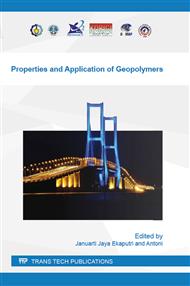p.79
p.83
p.90
p.98
p.104
p.111
p.118
p.126
p.133
Flexural Strength of Low Calcium Class F Fly Ash-Based Geopolymer Concrete in Long Term Performance
Abstract:
This paper reports on experimental work that has been undertaken to investigate the flexural strength performance of fly ash-based geopolymer (FG) concrete. The FG concrete was prepared using low calcium class F fly ash with high silicate content. The flexural strength properties of FG were assessed using modulus of rupture test up to the age of 360 days. Compressive strength and Ultrasonic Pulse Velocity (UPV) tests were also performed to corroborate the flexural strength test results. The results showed that the FG concrete demonstrates a comparable compressive strength and velocity to OPC concrete. Hewever, the flexural strength of FG concrete exhibited a better performance compared to that OPC concrete. The measured flexural strength of FG concrete also exhibited a higher value compared to the predicted one using ACI 318M-08 standard. The relationship between flexural strength with compressive strength demonstrated a similarity behavior to that OPC concrete. Thus, it can be concluded that the use of the ACI standard can be applied conservatively to determine the flexural strength of fly ash-based geopolymer concrete.
Info:
Periodical:
Pages:
104-110
Citation:
Online since:
January 2016
Authors:
Price:
Сopyright:
© 2016 Trans Tech Publications Ltd. All Rights Reserved
Share:
Citation:


